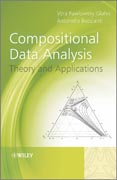
Compositional data analysis: theory and applications
Pawlowsky-Glahn, Vera
Buccianti, Antonella
This book presents the state-of-the-art in compositional data analysis and will feature a collection of papers covering theory, applications to various fields of science and software. Areas covered will range from geology, biology, environmental sciences, forensic sciences, medicine and hydrology. Key features: Provides the state-of-the-art text in compositional data analysis Covers a variety of subject areas, from geology to medicine Written by leading researchers in the field Is supported by a website featuring R code ÍNDICE: List of Contributors Preface Part One Introduction 1 A short history of compositional data analysis 1.1 Introduction 1.2 Spurious correlation 1.3 Log and log-ratio transforms 1.4 Subcompositional dependence 1.5 alr, clr, ilr: which transformation to choose? 1.6 Principles, perturbations and back to the simplex 1.7 Biplots and singular value decompositions 1.8 Mixtures 1.9 Discrete compositions 1.10 Compositional processes 1.11 Structural, counting and rounded zeros 1.12 Conclusion References 2 Basic concepts and procedures 2.1 Introduction 2.2 Election data and raw analysis 2.3 The compositional alternative 2.4 Geometric settings 2.5 Center and variability 2.6 Conclusion ReferencesPart Two Theory - Statistical Modelling 3 The principle of working on coordinates 3.1 Introduction 3.2 The role of coordinates in statistics 3.3 The simplex 3.4 Move or stay in the simplex 3.5 Conclusions References 4 Dealing with zeros 4.1 Introduction 4.2 Rounded zeros 4.3 Count zeros 4.4 Essential zeros 4.5Difficulties, troubles and challenges References 5 Robust statistical analysis 5.1 Introduction 5.2 Elements of robust statistics from a compositional point of view 5.3 Robust methods for compositional data 5.4 Case studies 5.5 Summary References 6 Geostatistics for compositions 6.1 Introduction 6.2 A brief summary of geostatistics 6.3 Cokriging of regionalised compositions6.4 Structural analysis of regionalised composition 6.5 Dealing with zeros: replacement strategies and simplicial indicator cokriging 6.6 Application 6.7 Conclusions References 7 Compositional VARIMA time series 7.1 Introduction 7.2 The simplex SDas a compositional space 7.3 Compositional time series models 7.4 CTS modelling: an example 7.5 Discussion 7.6 AppendixReferences 8 Compositional data and correspondence analysis 8.1 Introduction 8.2 Comparative technical definitions8.3 Properties and interpretation of LRA and CA 8.4 Application to fatty acidcompositional data 8.5 Discussion and conclusions References 9 Use of survey weights for the analysis of compositional data 9.1 Introduction 9.2 Elements of survey design 9.3 Application to compositional data 9.4 Discussion References 10 Notes on the scaled Dirichlet distribution 10.1 Introduction 10.2 Genesisof the scaled Dirichlet distribution 10.3 Properties of the scaled Dirichlet distribution 10.4 Conclusions References Part Three Theory - Algebra and Calculus 11 Elements of simplicial linear algebra and geometry 11.1 Introduction 11.2 Elements of simplicial geometry 11.3 Linear functions 11.4 Conclusions References 12 Calculus of simplex-valued functions 12.1 Introduction 12.2 Limits, continuity and differentiability 12.3 Integration 12.4 Conclusions References 13 Compositional differential calculus on the simplex 13.1 Introduction 13.2 Vector-valued functions on the simplex 13.3 C-derivatives on the simplex 13.4 Example: Experiments with mixtures 13.5 Discussion References Part Four Applications 14 Proportions, percentages, ppm: do th
- ISBN: 978-0-470-71135-4
- Editorial: John Wiley & Sons
- Encuadernacion: Cartoné
- Páginas: 400
- Fecha Publicación: 23/09/2011
- Nº Volúmenes: 1
- Idioma: Inglés
